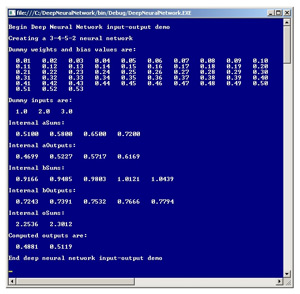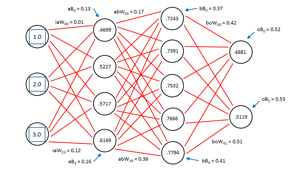深度神经网络入门教程Deep Neural Networks: A Getting Started Tutorial
Deep Neural Networks are the more computationally powerful cousins to regular neural networks. Learn exactly what DNNs are and why they are the hottest topic in machine learning research.
The term deep neural network can have several meanings, but one of the most common is to describe a neural network that has two or more layers of hidden processing neurons. This article explains how to create a deep neural network using C#. The best way to get a feel for what a deep neural network is and to see where this article is headed is to take a look at the demo program in Figure 1 and the associated diagram inFigure 2.
Both figures illustrate the input-output mechanism for a neural network that has three inputs, a first hidden layer ("A") with four neurons, a second hidden layer ("B") with five neurons and two outputs. "There are several different meanings for exactly what a deep neural network is, but one is just a neural network with two (or more) layers of hidden nodes." 3-4-5-2 neural network requires a total of (3 * 4) + 4 + (4 * 5) + 5 + (5 * 2) + 2 = 53 weights and bias values. In the demo, the weights and biases are set to dummy values of 0.01, 0.02, . . . , 0.53. The three inputs are arbitrarily set to 1.0, 2.0 and 3.0. Behind the scenes, the neural network uses the hyperbolic tangent activation function when computing the outputs of the two hidden layers, and the softmax activation function when computing the final output values. The two output values are 0.4881 and 0.5119.



Research in the field of deep neural networks is relatively new compared to classical statistical techniques. The so-called Cybenko theorem states, somewhat loosely, that a fully connected feed-forward neural network with a single hidden layer can approximate any continuous function. The point of using a neural network with two layers of hidden neurons rather than a single hidden layer is that a two-hidden-layer neural network can, in theory, solve certain problems that a single-hidden-layer network cannot. Additionally, a two-hidden-layer neural network can sometimes solve problems that would require a huge number of nodes in a single-hidden-layer network.
This article assumes you have a basic grasp of neural network concepts and terminology and at least intermediate-level programming skills. The demo is coded using C#, but you should be able to refactor the code to other languages such as JavaScript or Visual Basic .NET without too much difficulty. Most normal error checking has been omitted from the demo to keep the size of the code small and the main ideas as clear as possible.
The Input-Output Mechanism
The input-output mechanism for a deep neural network with two hidden layers is best explained by example. Take a look at Figure 2. Because of the complexity of the diagram, most of the weights and bias value labels have been omitted, but because the values are sequential -- from 0.01 through 0.53 -- you should be able to infer exactly what the unlabeled values are. Nodes, weights and biases are indexed (zero-based) from top to bottom. The first hidden layer is called layer A in the demo code and the second hidden layer is called layer B. For example, the top-most input node has index [0] and the bottom-most node in the second hidden layer has index [4].
In the diagram, label iaW00 means, "input to layer A weight from input node 0 to A node 0." Label aB0 means, "A layer bias value for A node 0." The output for layer-A node [0] is 0.4699 and is computed as follows (first, the sum of the node's inputs times associated with their weights is computed):
(1.0)(0.01) + (2.0)(0.05) + (3.0)(0.09) = 0.38
Next, the associated bias is added:
0.38 + 0.13 = 0.51
Then, the hyperbolic tangent function is applied to the sum to give the node's local output value:
tanh(0.51) = 0.4699
The three other values for the layer-A hidden nodes are computed in the same way, and are 0.5227, 0.5717 and 0.6169, as you can see in both Figure 1 and Figure 2. Notice that the demo treats bias values as separate constants, rather than the somewhat confusing and common alternative of treating bias values as special weights associated with dummy constant 1.0-value inputs.
The output for layer-B node [0] is 0.7243. The node's intermediate sum is:
(0.4699)(0.17) + (0.5227)(0.22) + (0.5717)(0.27) + (0.6169)(0.32) = 0.5466
The bias is added:
0.5466 + 0.37 = 0.9166
And the hyperbolic tangent is applied:
tanh(0.9166) = 0.7243
The same pattern is followed to compute the other layer-B hidden node values: 0.7391, 0.7532, 0.7666 and 0.7794. The values for final output nodes [0] and [1] are computed in a slightly different way because softmax activation is used to coerce the sum of the outputs to 1.0. Preliminary (before activation) output [0] is:
(0.7243)(0.42) + (0.7391)(0.44) + (0.7532)(0.46) + (0.7666)(0.48) + (0.7794)(0.50) + 0.52 = 2.2536
Similarly, preliminary output [1] is:
(0.7243)(0.43) + (0.7391)(0.45) + (0.7532)(0.47) + (0.7666)(0.49) + (0.7794)(0.51) + 0.53 = 2.3012 Applying softmax, final output [0] = exp(2.2536) / (exp(2.2536) + exp(2.3012)) = 0.4881. And final output [1] = exp(2.3012) / (exp(2.2536) + exp(2.3012)) = 0.5119
The two final output computations are illustrated using the math definition of softmax activation. The demo program uses a derivation of the definition to avoid arithmetic overflow.
Overall Program Structure
The overall structure of the demo program, with a few minor edits to save space, is presented in Listing 1. To create the demo, I launched Visual Studio and created a new project named DeepNeuralNetwork. The demo has no significant Microsoft .NET Framework version dependencies, so any relatively recent version of Visual Studio should work. After the template-generated code loaded into the editor, I removed all using statements except the one that references the top-level System namespace. In the Solution Explorer window I renamed the file Program.cs to the slightly more descriptive DeepNetProgram and Visual Studio automatically renamed class Program for me.
Listing 1: Overall Demo Program Structure
using System;
namespace DeepNeuralNetwork
{
class DeepNetProgram
{
static void Main(string[] args)
{
Console.WriteLine("Begin Deep Neural Network demo"); Console.WriteLine("Creating a 3-4-5-2 network");
int numInput = 3;
int numHiddenA = 4;
int numHiddenB = 5;
int numOutput = 2; DeepNeuralNetwork dnn =
new DeepNeuralNetwork(numInput,
numHiddenA, numHiddenB, numOutput); double[] weights = new double[] {
0.01, 0.02, 0.03, 0.04, 0.05, 0.06, 0.07, 0.08, 0.09, 0.10,
0.11, 0.12, 0.13, 0.14, 0.15, 0.16, 0.17, 0.18, 0.19, 0.20,
0.21, 0.22, 0.23, 0.24, 0.25, 0.26, 0.27, 0.28, 0.29, 0.30,
0.31, 0.32, 0.33, 0.34, 0.35, 0.36, 0.37, 0.38, 0.39, 0.40,
0.41, 0.42, 0.43, 0.44, 0.45, 0.46, 0.47, 0.48, 0.49, 0.50,
0.51, 0.52, 0.53 }; dnn.SetWeights(weights); double[] xValues = new double[] { 1.0, 2.0, 3.0 }; Console.WriteLine("Dummy weights and bias values are:");
ShowVector(weights, 10, 2, true); Console.WriteLine("Dummy inputs are:");
ShowVector(xValues, 3, 1, true); double[] yValues = dnn.ComputeOutputs(xValues); Console.WriteLine("Computed outputs are:");
ShowVector(yValues, 2, 4, true); Console.WriteLine("End deep neural network demo");
Console.ReadLine();
} static public void ShowVector(double[] vector, int valsPerRow,
int decimals, bool newLine)
{
for (int i = 0; i < vector.Length; ++i)
{
if (i % valsPerRow == 0) Console.WriteLine("");
Console.Write(vector[i].ToString("F" + decimals) + " ");
}
if (newLine == true) Console.WriteLine("");
}
} // Program public class DeepNeuralNetwork { . . } }
The program class consists of the Main entry point method and a ShowVector helper method. The deep neural network is encapsulated in a program-defined class named DeepNeuralNetwork. The Main method instantiates a 3-4-5-2 fully connected feed-forward neural network and assigns 53 dummy values for the network's weights and bias values using method SetWeights. After dummy inputs of 1.0, 2.0 and 3.0 are set up in array xValues, those inputs are fed to the network via method ComputeOutputs, which returns the outputs into array yValues. Notice that the demo illustrates only the deep neural network feed-forward mechanism, and doesn't perform any training.
The Deep Neural Network Class
The structure of the deep neural network class is presented in Listing 2. The network is hard-coded for two hidden layers. Neural networks with three or more hidden layers are rare, but can be easily created using the design pattern in this article. A challenge when working with deep neural networks is keeping the names of the many weights, biases, inputs and outputs straight. The input-to-layer-A weights are stored in matrix iaWeights, the layer-A-to-layer-B weights are stored in matrix abWeights, and the layer-B-to-output weights are stored in matrix boWeights.
Listing 2: Deep Neural Network Class Structure
public class DeepNeuralNetwork
{
private int numInput;
private int numHiddenA;
private int numHiddenB;
private int numOutput; private double[] inputs; private double[][] iaWeights;
private double[][] abWeights;
private double[][] boWeights; private double[] aBiases;
private double[] bBiases;
private double[] oBiases; private double[] aOutputs;
private double[] bOutputs;
private double[] outputs; private static Random rnd; public DeepNeuralNetwork(int numInput, int numHiddenA,
int numHiddenB, int numOutput) { . . }
private static double[][] MakeMatrix(int rows, int cols) { . . }
private void InitializeWeights() { . . }
public void SetWeights(double[] weights) { . . }
public double[] ComputeOutputs(double[] xValues) { . . }
private static double HyperTanFunction(double x) { . . }
private static double[] Softmax(double[] oSums) { . . }
} from: https://visualstudiomagazine.com/articles/2014/06/01/deep-neural-networks.aspx
深度神经网络入门教程Deep Neural Networks: A Getting Started Tutorial的更多相关文章
- 用matlab训练数字分类的深度神经网络Training a Deep Neural Network for Digit Classification
This example shows how to use Neural Network Toolbox™ to train a deep neural network to classify ima ...
- 深度学习概述教程--Deep Learning Overview
引言 深度学习,即Deep Learning,是一种学习算法(Learning algorithm),亦是人工智能领域的一个重要分支.从快速发展到实际应用,短短几年时间里, ...
- [译]深度神经网络的多任务学习概览(An Overview of Multi-task Learning in Deep Neural Networks)
译自:http://sebastianruder.com/multi-task/ 1. 前言 在机器学习中,我们通常关心优化某一特定指标,不管这个指标是一个标准值,还是企业KPI.为了达到这个目标,我 ...
- 吴恩达《深度学习》-第一门课 (Neural Networks and Deep Learning)-第四周:深层神经网络(Deep Neural Networks)-课程笔记
第四周:深层神经网络(Deep Neural Networks) 4.1 深层神经网络(Deep L-layer neural network) 有一些函数,只有非常深的神经网络能学会,而更浅的模型则 ...
- 吴恩达《深度学习》-课后测验-第一门课 (Neural Networks and Deep Learning)-Week 4 - Key concepts on Deep Neural Networks(第四周 测验 – 深层神经网络)
Week 4 Quiz - Key concepts on Deep Neural Networks(第四周 测验 – 深层神经网络) \1. What is the "cache" ...
- 为什么深度神经网络难以训练Why are deep neural networks hard to train?
Imagine you're an engineer who has been asked to design a computer from scratch. One day you're work ...
- Neural Networks and Deep Learning 课程笔记(第四周)深层神经网络(Deep Neural Networks)
1. 深层神经网络(Deep L-layer neural network ) 2. 前向传播和反向传播(Forward and backward propagation) 3. 总结 4. 深层网络 ...
- 深度学习(六十九)darknet 实现实验 Compressing Deep Neural Networks with Pruning, Trained Quantization and Huffma
本文主要实验文献文献<Deep Compression: Compressing Deep Neural Networks with Pruning, Trained Quantization ...
- 《Improving Deep Neural Networks:Hyperparameter tuning, Regularization and Optimization》课堂笔记
Lesson 2 Improving Deep Neural Networks:Hyperparameter tuning, Regularization and Optimization 这篇文章其 ...
随机推荐
- 【转】Web标准中的常见问题
本文转自http://www.tracefact.net/Misc/Common-Problems-Of-Web-Standard.aspx 引言 大概在2004年的时候,Web标准的概念藉由一本名为 ...
- c语言之fopen参数(r+,w+,a+)
经查找一些资料,并且亲自实验之后得出: r+:打开已存在的文件时,光标位于开头,文件可读,可写, 写数据时,由于光标位于开头,所以会覆盖原有数据 w+:打开的文件已存在时,将覆盖原文件 a+:打开已存 ...
- linux 文件属性
关于属性的结构 在linux下文件和文件夹都被认为是文件, 所以以下的这个属性对文件和文件夹通用 获取属性的函数有stat/fstat/lstat/fstat struct stat{ mode_t ...
- keyboard
一 按键驱动程序的简单实现 下面是基于中断和消息的按键驱动程序,其工作原理是:当应用程序读取键值时,会调用按键驱动程序的read函数,而我们实现的read函数检测完读取长度后没有直接读取键值而是等待按 ...
- centos crontab 定时任务详解
安装crontab: yum install crontabs 说明: /sbin/service crond start //启动服务 /sbin/service crond stop //关闭服务 ...
- windows鼠标消息处理与键盘模拟函数
1.鼠标坐标问题 BOOL GetWindowRect( HWND hWnd, LPRECT lpRect ); RECT x;//定义一个二维数组x ::GetWindowRect(hwn ...
- WinForm中Component Class、User Control及Custom Control的区别和使用-转
转http://www.cnblogs.com/jhtchina/archive/2010/11/28/1028591.html NET Framework 为您提供了开发和实现新控件的能力.除了常见 ...
- Codeforces Round #327 (Div. 1) B. Chip 'n Dale Rescue Rangers 二分
题目链接: 题目 B. Chip 'n Dale Rescue Rangers time limit per test:1 second memory limit per test:256 megab ...
- 【锋利的JQuery-学习笔记】遮罩层
效果图: 鼠标移动到上面后---> html: <div id="jnBrandList"> <ul> <li> <a href= ...
- 【面试题013】在O(1)时间删除链表结点
[面试题013]在O(1)时间删除链表结点 我们要删除结点i,我们可以把结点i的下一个结点j的内容复制到结点i,然后呢把结点i的指针指向结点j的下一个结点.然后在删除结点j. 1.如果结点i位于链表 ...
